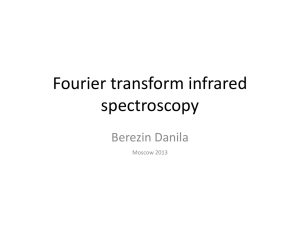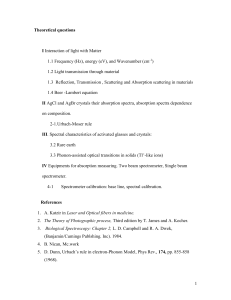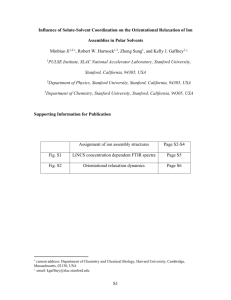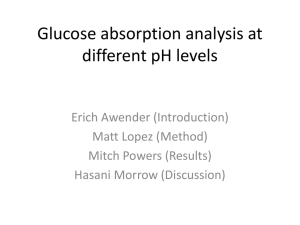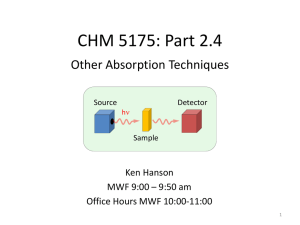Experimental Determination of Properties of Solids
advertisement
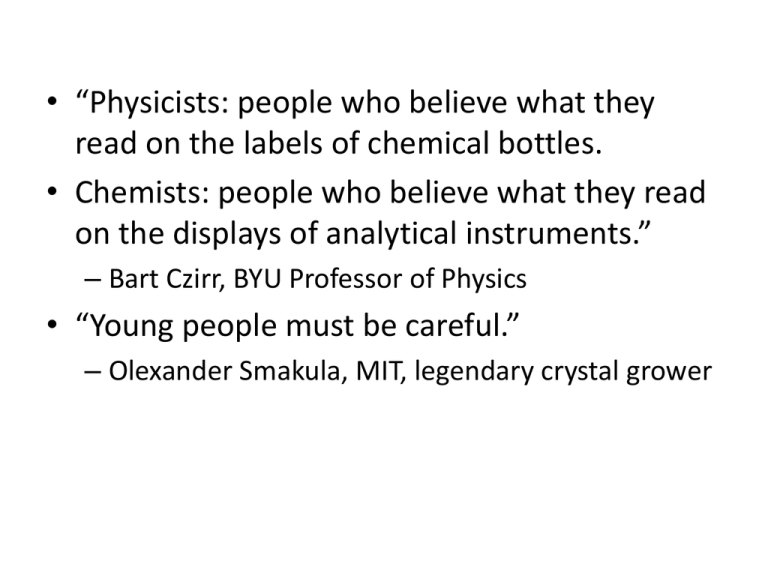
• “Physicists: people who believe what they
read on the labels of chemical bottles.
• Chemists: people who believe what they read
on the displays of analytical instruments.”
– Bart Czirr, BYU Professor of Physics
• “Young people must be careful.”
– Olexander Smakula, MIT, legendary crystal grower
Properties of Solids
Measurement and Characterization
Matt DeLong
18 March 2011
Lab Tasks
• Each pair of you will be given an unknown
semiconductor
• Determine index of refraction
• Determine thickness of thin silicon film on
sapphire and entire substrate
• Determine band gap of material
• Determine energies of free carrier absorption
and phonon modes
• Determine lattice constant of material
• Identify material and doping level from
resistivity
Measurement Techniques to Be Used
• Transmission/absorption with Cary 17DX
UV/Visible/NIR spectrometer
• Transmission/absorption with Bruker IFS88
Fourier Transform InfraRed spectrometer (FTIR)
• Witech NSOM with micro-Raman attachment;
Ar+ laser excitation
• X-ray powder diffractometer
Optical Absorption
Pankove chapter 3
GaAs 300 K
Inter-band transitions leading
to strong absorption
Absorption coefficient (cm-1)
Typically visible or near IR
Additional use of
absorption
measurements to
investigate
semiconducting solids
Note units:
absorption coefficient
(cm-1) as a function of
photon energy (eV)
Beer’s Law
• I (λ,t) = I0e-α(λ)t
• Light intensity reduction after transiting a
piece of material whose thickness is t and
whose absorption coefficient is α(λ).
• Absorbance ≡ log10 (I0/I) = αtlog(e) = α’t
• Transmittance ≡ I/I0
• Percent transmission ≡ 100 x Transmittance
• Reflectance ≡ IR/I0
Absorbance =
Optical Density
0
0.1
0.25
0.5
0.75
0.9
1
2
3
Transmittance
(I / I0)
1
0.79
0.56
0.32
0.18
0.13
0.1
0.01
0.001
Percent
transmittance
(100 * I / I0)
100
79
56
32
18
13
10
1
0.1
Conservation of Energy
• Incident light is reflected, transmitted or
absorbed by sample.
• Reflected light is responsible for baseline shift
4-32
In regions of
minimal
absorption
• Baseline offset can be used to calculate index
of refraction of material
•
Pankove 4-26
Baseline is about 0.3 away from absorption peaks
100.3 = .5 = IT/I0
T = 0.5 =
R = 0.33
n = 3.7
c.f. n = 3.4 in
Pankove table
Common Units Used in Spectroscopy
(Have you ever noticed that the human brain likes to work in small, whole numbers?)
•
•
•
•
E = hν = hc( )
hc = 1240 eV-nm = 1.24 eV-μm
Energy is always measured in eV
Wavelength is measured in nm or μm (or Å = 10-10 m)
• In the IR energy is measured in “wavenumbers”
• 1 “wavenumber” = 1 cm-1.
• Obviously λ( ) = 1
• 10,000 μm x 1 cm-1 = 1
• Product of wavelength (in microns) and wavenumber (in
cm-1) is 10,000.
Transmission
Windows
Grating spectrometer
I0 is detector output voltage when signal passes through reference.
I is detector output voltage when signal passes through sample.
Courtesy of Kathrine Skollingsberg
• “Half-silvered mirror”: 50% of mirror surface is
nominally 100% reflective
• Mirror rotates
• 50% of time beam
is reflected, 50%
of time is transmitted,
so beam alternately
follows two paths
Courtesy of Kathrine Skollingsberg
Cary 17DX: Entire Unit
Reflectivity
attachment
Cell Compartments
Operation of Dispersive Spectrometer
• Conceptually very simple.
– Detector output is proportional to amount of light
transmitted by sample.
– Assumption: light not transmitted was absorbed or
reflected
• Energy-independent loss of intensity is due to reflection
• “Baseline offset” can be used to calculate index of
refraction
• Very important: Resolution depends on slit
width
– Resolution is inversely proportional to intensity of
light transmitted/detected.
Technical Details
• 200 nm < λ < 2500 nm possible
• Deuterium lamp puts out greater intensity for
200 nm < λ < 500 nm
• Tungsten lamp is more intense for 500 nm < λ
• PMT has greater signal-to-noise for λ < 900
nm.
• PbS detector is superior for 900 nm < λ
• Cuvette and holder allow measuring
transmission for liquids
The IR Beyond About 3 microns
• Sources are weak
– Think of the black body emission curves!
• Detectors are less sensitive
• Transitions typically caused by
– molecular vibrations
– Rotations
– Free carrier absorption
• FTIR to the rescue!
Onward Into the IR: the FTIR
A Michelson
Interferometer
www3.wooster.edu
Source of
Illumination here
Crucial image correlating zero crossings
of laser interferences and data sampling
of signal at detector
Δx
Not Conceptually Simple!
• For the two beams headed toward the
detector after having been transmitted and
reflected by the beamsplitter after having first
been reflected and transmitted by the
beamsplitter, then (second) reflected by the
moving and fixed mirrors, respectively.
• Now is that clear?
Intensity of Light Headed to Sample
• I(Δd) = B(k){1 + cos(k Δd)}
• I(Δd) is the intensity measured at the detector
as a function of path difference between
beams going to fixed or moving mirror
• B(k) is the “wavelength” dependence of the
source emission as modified by all elements
along the beam path.
• Obviously
• Since k and Δd are Fourier conjugates, the
Fourier transform of I(Δd) gives I(k) = I(1/ λ)
FTIR
Operating
parameters
Interferogram
Relative position coordinate of moving mirror
IR Spectrum: Fourier Transform of I(Δd)
Spectrum with Plastic Bag
Difference
between
absorption
spectra of
plastic bag
and empty
chamber
Operational Difference Between
Spectrometers
• How to account for background effects?
• Cary does this by splitting beam between two
paths which travel through identical media
except one contains sample.
– Data collected nearly simultaneously
• FTIR is sufficiently stable that background
signal can be subtracted “long” after it has
been taken.
Operational Difference Between
Spectrometers
• Resolution
– Grating
• Resolution increased by narrowing slits
• Narrowing slits decreases signal
• Decreasing signal decreases signal-to-noise
– FTIR
• Resolution increased by increasing amplitude of moving
mirror
• Increasing moving mirror path length increases scan
time
• Increasing resolution does not affect signal-to-noise
Film Thickness Measurements
• Can be done with any spectrometer
• Film must be of uniform thickness
•Thick films require FTIR
to be set for high
resolution
•mλ = 2nt
•Normal incidence
•n = index of
refraction
•t = film thickness
•m = index number
1002.3
1055
X-ray Diffractometry
• Bragg’s Law
– mλ = 2d(h,k,l)sin(θ)
– m = integer
– λ = x-ray wavelength
– d(h,k,l) = interplanar
lattice spacing
– θ = scattering angle
X-ray Diffractometry
• Technique uses monochromatic x-rays
• Powdered crystal used
– X-ray beam intersects micro-crystals oriented in all
directions
– Micro-crystals are basically an “analog computer”
that solves the Bragg Equation
– Discrete values of d(h, k, l) lead to discrete values
of θ[d(h,k,l)]
– Discrete values of θ[d(h,k,l)] have cylindrical
symmetry about beam axis
– X-ray detector scans a diameter of hemisphere
into which beam is scattered
Cullity Fig. 3-12.
Debeye-Scherer powder
diffraction patterns
X-rays are spatially
dispersed onto film.
Diffractometer: identical
except detector scans
circumference as a
function of time.
Diffractometer Spectrum
(Random example from the web)
Since λ is known,
d(h,k,l) can be calculated
for each line.
home.ptad.pt
Resistivity Measurements
•Reference: www.keithley.com/data?asset=15222
•Fourprobe_resistivity_AN2.pdf on course website
ρ = bulk resistivity
V = voltage measured
between inner probe pins
I = current applied between
outer probe pins
t = sample thickness
k = correction factor, SEMI
MF84-02
More on Resistivity
• 4-point probe works extremely well on silicon
• For III-V materials with reasonable conductivity,
indium contacts may be applied with a
dedicated soldering iron tip
• Indium melts at 156 C
• Indium may be diffused into the wafer at 200 C
under a reducing atmosphere (hydrogen)
• Sophomore physics:

